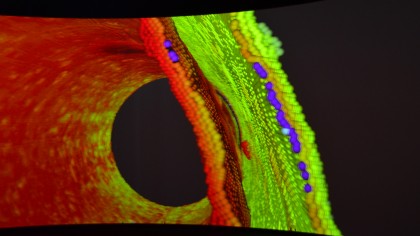A university in Sydney is turning scientists into Minority Report agents
Data manipulation just got a whole lot more interesting.

This week, the University of Technology Sydney released a new multimedia room called the Data Arena, to help researchers look at data in ways that haven't been possible before.
Imagine standing in a perfectly circular ten-meter-wide room surrounded on all sides by four-meter-high projector screen walls with a closable screen-door, creating a seamless 360º viewing platform.
Then add in six stereoscopic 3D projectors powered by a rig running nine high-quality Nvidia graphics cards and a 16 speaker surround sound system, and you might get an idea of what this 20K display looks like in real life.

Not a lonely VR experience
Sprinkle on top a set of remotes that look like miniature molecular models and allow up to 20 people to interact with the display, and this Data Arena becomes as close as the real world gets to Minority Report or the Holodeck from Star Trek.
The man behind the Data Arena's curtain, Ben Simons, was a former head of visual effects at Dr D Studios and worked on animated films like Happy Feet and Mad Max: Fury Road. So the fact that the Data Arena looks like a futuristic film set is partially understandable.
But despite how impressive this multimedia cocoon looks, what is most interesting about the Data Arena is the open source software UTS built to run it.
The life of numbers

This software has been specifically designed to turn copious amounts of spreadsheet data - something that the scientific community has no shortage of – into larger than life interactive visual displays.
Sign up for breaking news, reviews, opinion, top tech deals, and more.
To demonstrate, UTS has already let some of its researchers at it, including Cynthia Whitchurch, an associate professor of microbiology at UTS who studies the migration of mycobacteria.
Whitchurch and other UTS researchers have been able to use the software to visualise the movement of bacteria across a flat surface, stating in a launch interview that, "The Data Arena has been able to provide us with a powerful visual tool that allows us to interact with our data in a way that we haven't yet been able to do."
The screen is the showpiece for the open source application that the university intends to make available to researchers around the world through GitHub. This will allow users to run their own research through the 3D modelling software virtually on any computer.
The limitations of the computer running the virtual machine software will, however, often only run a scaled back model of the data, meaning the Data Arena has a place as a more powerful tool for researchers to fully explore the parameters of the complete data models in real time.

Joel spent nearly nine years as one of TechRadar Australia's senior writers, testing and reviewing PCs, laptops and computer peripherals. He's even written extensively for APC Magazine in Australia. Now he contributes to TechRadar as the resident pizza maker and oven expert.